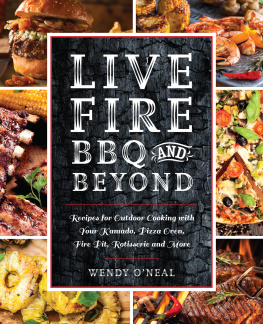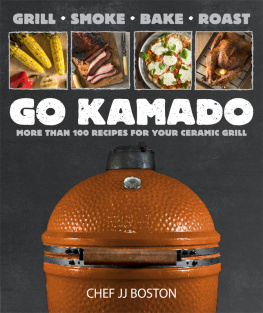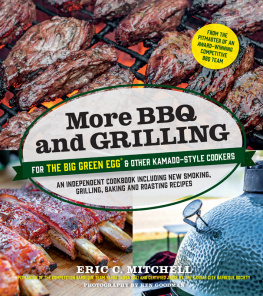

CONTENTS

FOREWORD
WE ARE CHEFS
Its been eight (Jeroen) and five (Leonard) years since we first encountered the Big Green Egg and found out about the kamado. Both of us were immediately sold on this intriguing cooking device, and from then on we began using one practically every day. We still do.
Since that first introduction, we have fired up our kamados at remarkable locations: Weve given demonstrations on both tropical beaches and alpine mountain summits. Weve cooked in weather conditions varying from a freezing 3F (-16C) to a scorching 95F (35C); in heavy winds, rain, and snow, or while basking in radiant sunlight. Weve cooked for world-famous chefs and shoppers at a local garden center, and catered to hundreds of guests with an exclusive dinner at our own restaurant.
Under all these different circumstances, while we often looked around in wonder, our kamados always stayed the same: reliable, responsive to temperature adjustments, and fuel efficient. We think now is the perfect moment for us to collect all our kamado experiences in a comprehensive book. Especially since these days, more and more people are discovering the kamado as an appliance that will change backyard grilling into full-fledged outdoor cooking.
Jeroen Hazebroek
Leonard Elenbaas

JEROEN HAZEBROEK (R)
AND LEONARD ELENBAAS

INTRODUCTION
Over the past few years, the popularity of the kamado cooker has grown rapidly. Each year, new brands appear on the market. Meanwhile, we have noticed an increasing demand from kamado users for information. The kamado has lured home cooks who never before would have considered firing up a grill in their backyards. After all, though this is an all-around cooking device, it is far removed from what were used to in our kitchens. For many barbecue enthusiastsand we consider ourselves part of this groupthe kamado is the logical next step on the way to becoming better, more versatile outdoor cooks. It offers us more cooking options and more control over cooking temperatures.
Make no mistake: A kamado is no magic box. It doesnt turn you into a three-star chef overnight. Even in a kamado, the food doesnt cook itself. The kamado will, however, significantly improve the results of your labor compared to what you are used to achieving with a regular barbecue grill. All it takes is investing some hours in learning how to cook with this device. If you are used to working with a kettle grill, youll likely have to unlearn a couple of things too. But with this book, we are going to help you improve your kamado cooking! To achieve this, we will discuss specific techniques and recipes for the kamado, and we will also take an in-depth look at the history and background of the kamado.
Brands and models in this book
In this book, we consciously dont advise what brand to buy. We understand that people weigh looks, cost, and quality before choosing a certain grill. For this book we have tested six different brands over a seven-month period. Each of these brands is used in the recipes and the cooking techniques discussed in this book. Considering the history of the kamado, which we will describe in the upcoming chapter, our selection of brands was quite straightforward. We worked with Kamado Joe, Grill Dome, Primo, Big Green Egg, Monolith, and the Broil King Keg. An important criterion in our selection of brands was their customer guarantee policy, because we believe that the level of warranty on ceramics is indicative of a manufacturers confidence in its products. For each of the brands we used, we can offer good reasons to choose that one. In the end, however, they are all kamados.
Another thing wed like to mention is that we have limited ourselves to working with standard models. Depending on the brand, theyre called large, standard, or classic. These models have a cooking grid diameter of between 18 and 20 inches (45 and 50 cm). Almost all brands offer both smaller and larger models. The difference between these and the standard models lies mostly in their capacity. Only the smallest models, with a cooking grid diameter of less than 12 inches (30 cm), operate differently because some of them lack a heat shield.
How does this book work?
In most cookbooks, the reader will feel an understandable urge to immediately skip to the actual recipes, forgoing the explanatory text at the beginning. We put most recipes in the second half of the book; if you feel confident about your kamado skills and you want to start right away, by all means, go ahead! Maybe later on you can take some time to learn a little more about the background and history of this type of grill.
:
What is a kamado and what are its origins?
What are the inner workings of a kamado?
Which type of fuel works best?
What types of accessories are available, and which ones do you need?
How does the use of a kamado influence the flavor of dishes?
How do you fire up a kamado, and how do you control the temperature?
What do you need to know about maintenance and repairs?
, you will find nineteen recipes in which we go over all the discussed techniques once more. Some recipes are easy to prepare; othersthe pig head rillettes, for instance, or the turkeyrequire more effort, time, and bravery. You will notice how, with this book in hand, you will be increasingly enticed to prepare your daily meal on the kamado. Not just meat and fish, but also vegetables, breads, and desserts; and not just during the summer, but throughout the year.
CHAPTER 1
THE HISTORY OF THE KAMADO
To better understand the configuration and workings of the kamado, it is important to take a closer look at its history. We werent satisfied with the version of its history as told by many websites and manuals of modern kamado brands. These often consisted of a vague reference to a Chinese cooking device dating from the Qin dynasty, followed by a glowing story about the founder of the brand in question. We went on a quest, looking for kamado references in books on culinary history and cooking techniques. We also researched a score of obscure online sources, coming across interesting websites from both Japan and the United States.

FIRE PIT
A kamado is a ceramic barbecue grill and oven, which in its current iteration has been around for a little more than a century. If it werent for the American military presence in Japan during the aftermath of World War II, we most likely would have never heard of kamados. The origins of ceramic vessels date back further, at least five thousand years, by way of China and India and all the way to the earliest tandoors that were used in the Indus Valley (present-day Syria and Iraq).
Next page















